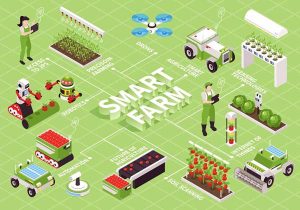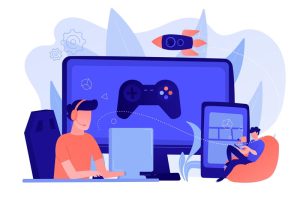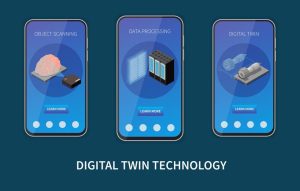A digital twin is a copy of an object in the digital world. It could be a product, a machine, or even a building. For most businesses, the virtual copy is linked to a real data stream from the real-world object’s sensor. This information makes the real object move, act, or provide services in a virtual world.
The active situation tends to help the developers understand the problems these real-world objects face and how they act in different situations. For example, the digital twin of an intelligent building helps the person who made it figure out what happens to the whole building if a sensor breaks or how to regulate the whole thing better.
The Strange Relationship Between Digital Twins and Real Estate
Digital twins are programs that make copies of real buildings. This is especially helpful for architects who wish to see how their plans will work. The cost of mistakes and unknowns is reduced when digital twins are used. Smart buildings can also get much out of the digital twins in building models. Smart buildings have become the norm in the building industry over time.
This process, made possible by technology, helps the real estate industry more strategically. Since these are like smart buildings, the people who make them use them to improve operations and the customer experience, but a twin can also help throughout the whole lifecycle of a structure by simulating complex situations.
What role does a digital twin play in building real estate?
Let’s look at the role of the digital twin in real estate as well as the life cycle of a building to learn more about how they are related.
Improve Individual Results of the System
Digital twins let you completely change important things like the air quality, the furniture, the temperature control, and the facilities. By changing the whole point of view, the developers can see how people can reach all of these points.
By looking at the whole building ecosystem, digital twins let you optimize much more than simple tasks like how much energy is used. Because buildings are complicated, they are a good choice for getting the most out of a digital twin. They are high-value assets with a lifecycle that is just as complicated. Buildings are much more than just property.
They affect how people interact with each other and build communities. They also can improve the system’s outcome, make customers more loyal to a brand, and make people healthier, happier, and more productive. So, the digital twins work together to give people a place to live and work.
Integration
A digital town is a model that is easy to handle. With the assistance of digital twins, developers can break up a big project into smaller models that are all connected. Creating smaller digital twins of the project helps the projects come together more slowly. Also, these things happen as a result of these modular integrations.
- The development of a twin can move along more quickly.
- The best way to get momentum is to make use cases work better.
- Realizes immediate benefit and sets up a plan for creating a full digital twin of a building over its whole lifecycle.
Find the weaknesses in the security system.
With the assistance of digital twins, it will be easier to see how people use a building and, eventually, to simulate and anticipate how tenants would move around and interact. This will make managing the lighting and HVAC systems easier and set up a better cleaning schedule while still meeting visitors’ needs. Improving the system will save money immediately and for a long time, increase trust in the digital twin, and make it possible to use it more complexly.
Enables Sustainability
The digital twin real estate model can help building and site managers make their businesses more environmentally friendly. Using digital twins of the buildings’ ecosystems, managers can keep track of CO2 emissions, smog, and waste collection at the building.
Designers can simulate different outcomes and see what happens when they change their models, like switching to an energy system that is better for the environment. In the context of smart cities, every institute can support using digital twins to build ecologically friendly or green real estate developments.
Collecting more detailed information
The real estate business is being turned upside down by the growing use of digital twins, IoT, and mobile devices. Digital twins are a new type of technology that will make it possible to see the data and functions of a building in real-time.
With the help of digital twins, real estate agents can show potential buyers what they can accomplish with the money. They give a good idea of how the finished product will look before it is built. Also, they give more specific info on how a building works, so problems can be found and fixed before they happen.
Facilities Management
Digital twins can save both time and money by making it easier to manage digital twins. A digital twin includes or shows both the design plan for a building and the most up-to-date information about its ecosystem. So, the people who run the building could use digital twins to find problem areas and fix them more effectively.
Accurate and quick solutions to problems lead to fewer disruptions, which makes residents happier. In the most basic designs, each building has its building. Most of the time, there are documents, drawings, and notes. With the digital twins’ effective solutions, the manager will be able to utilize the documents as soon as possible instead of spending a lot of time looking through them to locate the needed data.
Digital Twins: The New Approach To Thinking About Buildings
Digital twins assist in planning and visualizing the whole building process and finding ways to improve it. The digital twin technology makes it easier to run the building because it can accurately predict how decisions and delays will affect the whole project. Also, the ability to monitor safety and compliance in real-time can stop accidents from happening and save lives.
It grows when a new simulation or use case is added to a digital twin. During the structure’s lifecycle, the twin can gradually get a full view of the whole thing and connect any unconnected systems to make a central place for all data and decisions.
And there’s no doubt that architects will start to design buildings in completely new ways once they have access to advanced simulations that can be used to try out ideas. As soon as a mistake is made, the digital twin in building projects lets the developer know right away.
This makes it easy for the construction planner to schedule a contractor, tell them how to fix the problem, and give them specifications. Also, it will make it easier to make invoices, and self-maintenance buildings will become more common as people move toward custom spaces and multimodal workspaces that can adapt to the needs of different teams in almost real time.
Simulations will be used in workplaces to change the way space is set up and organized on the fly. Also, architects can test out new store designs with the help of the digital twin simulation. It makes places where customers can get to know each other better.
Simulations of staff and patients will be used in the healthcare field to reduce friction and bottlenecks. The twin model makes it easier to get medical supplies to everyone in the area. It also works out best to schedule staff to meet patients’ current and future needs.



